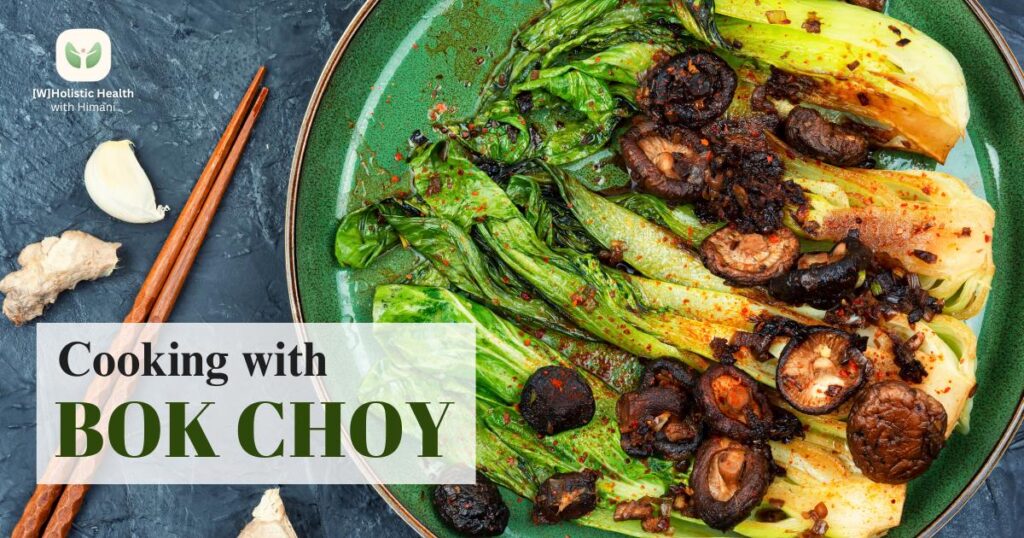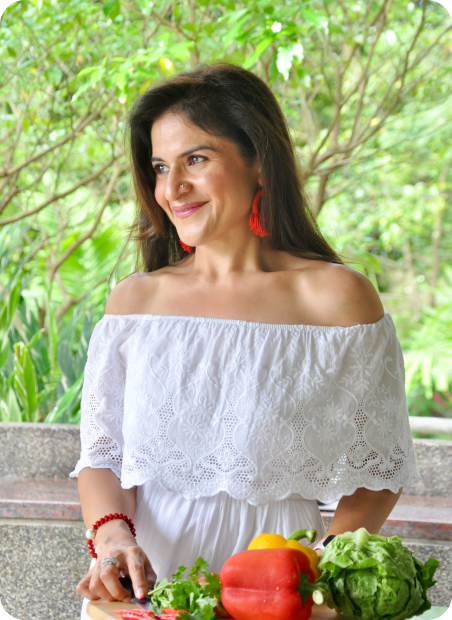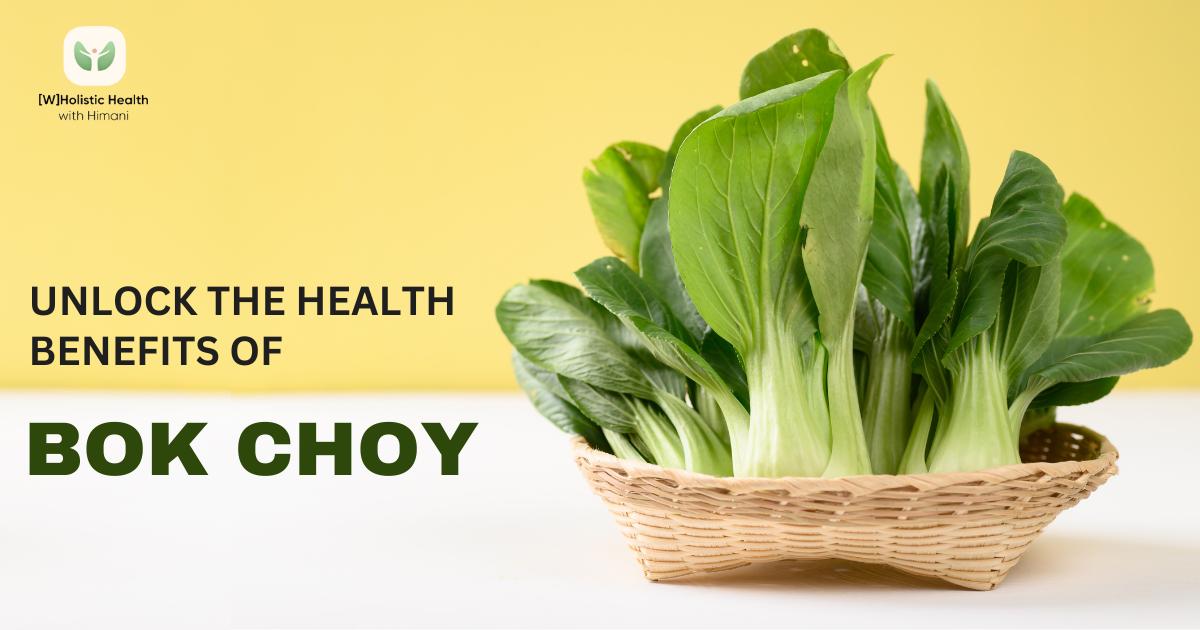Bok choy, a versatile leafy green vegetable deeply rooted in Asian culinary traditions, has emerged as a global culinary star, known scientifically as Brassica rapa subsp. Chinensis, a member of the cruciferous family, has been cultivated for over 5,000 years and originated in the fertile regions of China. Today, it graces tables worldwide, celebrated for its distinctive appearance, versatile nature, and impressive nutritional profile.
The vegetable’s structure is immediately recognizable: crisp, white stalks supporting dark green leaves, creating a natural contrast that adds visual appeal to any dish. While commonly known as Chinese cabbage in Western countries, bok choy differs significantly from the familiar round cabbage, offering a unique combination of textures and a mild, refreshing flavor that adapts well to various cooking methods.
Read More: Swiss Chard: Nutrition, Recipes, Health Benefits & Growing Guide
Table of Contents
ToggleHistorical Context and Cultural Significance
The history of bok choy is intrinsically linked to Chinese agriculture and cuisine. Archaeological evidence suggests its cultivation began in the Yangtze River Delta region, where it played a crucial role in sustaining populations through various dynasties. As Chinese communities migrated across Asia and eventually worldwide, bok choy traveled with them, becoming an essential ingredient in numerous Asian cuisines.
In traditional Chinese medicine, bok choy has been valued for its cooling properties and ability to promote digestive health. This understanding of its medicinal properties aligns with modern scientific research, which has revealed its impressive nutritional content and health benefits.
Nutritional Profile and Health Benefits of Bok Choy
Modern nutritional science has confirmed what traditional wisdom long suspected: bok choy is a powerhouse of essential nutrients. A single cup of raw bok choy contains merely 13 calories while providing significant amounts of vitamins A, C, and K, along with essential minerals such as calcium and iron. The vegetable’s high water content makes it an excellent choice for those seeking to maintain healthy hydration levels while consuming nutrient-dense foods.
Read More: The Ultimate Guide to Kale: Benefits, Recipes, and More
The health benefits of bok choy extend beyond its essential nutritional content. Its high levels of antioxidants, particularly beta-carotene and vitamin C, help combat oxidative stress in the body. Glucosinolates, unique to cruciferous vegetables, have been linked to potential cancer-fighting properties. Regular consumption of bok choy may contribute to improved bone health, enhanced immune function, and better vision, thanks to its diverse nutrient profile.
Nutritional Value of Bok Choy
Bok choy is a nutrient-dense vegetable that provides:
- High levels of vitamins A, C, and K
- Significant amounts of folate and B-vitamins
- Essential minerals, including calcium, iron, and potassium
- Antioxidants and phytonutrients
- Low calories (approximately 13 calories per 100g)
Varieties Of Bok Choy
While most consumers are familiar with the standard bok choy variety, several cultivars have unique characteristics. The traditional variety features tall, crisp stalks and dark green leaves, while Shanghai bok choy offers a more compact form with spoon-shaped leaves and light green stems. Baby bok choy, harvested early in its growth cycle, provides a more tender texture and delicate flavor, making it particularly popular in high-end cuisine.
When selecting bok choy, look for specimens with firm, crisp stalks and vibrant green leaves. The cut ends should appear fresh and moist, not dried out or discolored. Avoid plants with yellowing leaves, brown spots, or wilted appearances, as these indicate age or improper storage. Fresh bok choy should feel heavy for its size, indicating good water content and freshness.
Types of Bok Choy
- Regular bok choy: Large, mature plants with white stalks and dark green leaves
- Baby bok choy: Smaller, more tender variety with lighter green leaves
- Shanghai bok choy: Spoon-shaped leaves with light green stalks
- Dwarf bok choy: Compact variety ideal for small gardens
Cooking with Bok Choy

Basic Methods of Cooking Bok Choy
- Stir-frying: Retains its crispness and enhances flavor. Use high heat and cook briefly with garlic, ginger, and soy sauce.
- Steaming: Preserves nutrients and provides a tender texture. Ideal for serving with light sauces.
- Boiling: Softens Bok Choy quickly but may leach nutrients. Best for soups and stews.
- Roasting: Adds a smoky, caramelized flavor. Coat with olive oil and roast at 400°F (200°C) for 10-15 minutes.
Bok Choy in Asian Cuisine
Bok Choy is a staple in Chinese, Japanese, and Korean dishes:
- Chinese Cuisine: Used in stir-fries, hot pots, and braised dishes.
- Japanese Cuisine: Add to miso soup and serve with ramen.
- Korean Cuisine: Incorporated into kimchi and savory pancakes.
Bok Choy in Non-Asian Dishes
Its mild flavor and versatility allow it to be used in Western dishes:
- Salads: Raw Bok Choy adds crunch and freshness.
- Pasta: Pairs well with garlic and olive oil in pasta dishes.
- Vegetable Sautés: Complements carrots, bell peppers, and zucchini.
Bok Choy Substitutes
If Bok Choy is unavailable, suitable substitutes include:
- Swiss Chard: Offers a similar texture and slightly earthy flavor.
- Napa Cabbage: Provides a comparable crunch.
- Spinach: A softer option with a mild taste.
Bok Choy in Different Types of Dishes
- Main Courses: Often paired with protein like chicken, tofu, or shrimp.
- Side Dishes: Steamed or sautéed with garlic and soy sauce.
- Soups: Adds texture and nutrients to broths and noodle dishes.
Health Benefits of Bok Choy
Key Nutrients in Bok Choy
Bok Choy is packed with essential nutrients:
- Vitamin A: Supports vision and immune health.
- Vitamin K: Aids in blood clotting and bone health.
- Calcium: Promotes strong bones and teeth.
- Potassium: Helps regulate blood pressure.
How Bok Choy Supports Overall Health
- Bone Health: Rich in calcium, vitamin K, and magnesium, essential for maintaining bone density.
- Immune Function: High levels of vitamin C strengthen the immune system and help fight infections.
- Heart Health: Potassium and antioxidants support cardiovascular health by reducing blood pressure and combating inflammation.
Bok Choy for Certain Health Conditions
- Diabetes: Its low glycemic index and fiber helps stabilize blood sugar levels.
- Eye Health: Contains beta-carotene and lutein, which protect against age-related macular degeneration.
- Cancer Prevention: According to studies by the National Cancer Institute, glucosinolates in Bok Choy may have anti-cancer properties.
Comparison with Other Leafy Greens
Bok choy offers comparable or superior nutrition to many common greens:
- Higher calcium content than spinach
- More vitamin A than regular cabbage
- Better vitamin C levels than lettuce
- Lower oxalate content than many leafy greens
Tips for Incorporating Bok Choy into a Healthy Diet
- Add to smoothies for a nutrient boost.
- Use as a base for salads with sesame or citrus dressings.
- Stir-fry with other vegetables for a quick and healthy meal.
Bok Choy Benefits for Health
Bok Choy supports digestive health due to its high fiber content. It aids in detoxification and promotes skin health with its antioxidant properties. Additionally, it helps maintain a healthy weight as it is low in calories but nutrient-dense.
Preparing Bok Choy
How to Wash and Clean Bok Choy
Rinse thoroughly under running water, separating the leaves to remove dirt and grit. Soak in a bowl of water for stubborn debris.
Different Ways to Cut and Chop Bok Choy
- For Stir-Fries: Slice stalks and leaves separately for even cooking.
- For Soups: Cut into larger chunks to retain texture.
- For Salads: Thinly slice for a crisp addition.
Removing Bitterness from Bok Choy
Blanching in boiling water for 1-2 minutes can reduce bitterness.
Preparing Baby Bok Choy
Cook whole or halved for an elegant presentation. Baby Bok Choy is tender and requires less cooking time.
Using Different Parts of Bok Choy
- Leaves: Tender and ideal for quick cooking methods.
- Stalks: Crunchy and can be used in stir-fries or as a snack.
Cultivation and Growth
Growing bok choy at home can be a rewarding experience, as the plant is relatively easy to cultivate in most climates. It prefers cool weather and can grow in many regions as a spring and fall crop. The soil should be rich in organic matter, well-draining, and maintained at a pH between 6.0 and 7.0 for optimal growth.
Seeds can be sown directly in the garden or started indoors and transplanted. Depending on the variety, they should be planted approximately half an inch deep, with seedlings spaced 6-12 inches apart. The plants require consistent moisture but not waterlogged conditions. Most varieties reach maturity in 45-60 days, making them an excellent choice for gardeners seeking quick results.
Growing Steps
- Select well-draining soil
- Plant seeds 1/2 inch deep
- Space plants 6-12 inches apart
- Maintain consistent moisture
- Harvest in 45-60 days
Common Issues
- Pest management: Watch for cabbage worms and aphids
- Disease prevention: Avoid overhead watering
- Temperature control: Optimal growth at 55-70°F
- Soil requirements: Rich, well-draining soil
- Spacing considerations: Proper airflow
Bok Choy in Popular Dishes
Bok Choy in Stir-Fries
Toss with garlic, ginger, and soy sauce for a quick, flavorful dish. Add protein like chicken or shrimp for a complete meal.
Bok Choy in Soups and Stews
Bok Choy adds nutrients and texture to broths, such as chicken soup or miso-based stews.
Bok Choy in Noodle Dishes
Pair with soba, udon, or rice noodles for hearty meals. Bok Choy complements the flavors of soy sauce and sesame oil.
Bok Choy in Salads
Use raw leaves in fresh salads. Pair with orange segments, toasted almonds, and a sesame dressing.
Bok Choy in Side Dishes and Appetizers
Sauté Bok Choy with oyster sauce or chili oil for a quick, flavorful side dish.
Bok Choy Recipes Easy
For simple recipes, sauté Bok Choy with garlic and olive oil, or add it to a vegetable soup. Baby Bok Choy roasted with sesame oil is another easy option.
Bok Choy for Ramen
Traditional Bok Choy Ramen Recipe
Simmer Bok Choy with miso broth, noodles, and a soft-boiled egg. Top with green onions and sesame seeds.
Variations on Bok Choy Ramen
Include mushrooms, corn, or tofu for added texture and flavor. Adjust spice levels with chili oil or paste.
Pairing Bok Choy with Different Types of Noodles
Bok Choy works well with ramen, udon, and glass noodles. Its texture complements the softness of noodles.
Tips for Making the Perfect Bok Choy Ramen
Use fresh ingredients and cook Bok Choy until tender to retain its crunch.
Read More: Brussels Sprouts: Nutrition, Health Benefits, and Cooking
Recipe Ideas for Every Occasion
Quick Weeknight Dishes
- Garlic Bok Choy: A 10-minute side dish perfect for busy evenings
- Bok Choy and Tofu Stir-Fry: A protein-rich vegetarian main course
- Steamed Bok Choy with Oyster Sauce: A simple yet elegant preparation
Special Occasion Recipes
- Seafood and Bok Choy Stir-Fry: Perfect for entertaining
- Braised Baby Bok Choy: An elegant side dish for special dinners
- Bok Choy Dumplings: A creative way to incorporate the vegetable into appetizers
International Inspirations
- Korean-Style Bok Choy Kimchi: A unique fermented preparation
- Japanese-Inspired Miso Soup with Bok Choy: A Warming Comfort Dish
- Thai-Style Coconut Soup with Bok Choy: A fragrant, spicy option
Is Bok Choy Good for You?
Bok choy is exceptionally nutritious and offers numerous health benefits. One cup of raw bok choy contains only 13 calories while providing:
Significant nutritional content:
- 144% of daily vitamin A requirements
- 74% of vitamin C needs
- Over 50% of vitamin K recommended daily intake
- Important minerals including calcium, potassium, and iron
- Powerful antioxidants and anti-inflammatory compounds
The vegetable supports multiple aspects of health:
- Strengthens immune system through high vitamin C content
- Promotes bone health with vitamin K and calcium
- Supports eye health through vitamin A and beta-carotene
- Aids in cancer prevention through glucosinolates
- It helps maintain healthy blood pressure through potassium content
- Supports digestive health with fiber and water content
Regular consumption of bok choy as part of a balanced diet can contribute to overall wellness and may help prevent chronic diseases. Its low-calorie and high-nutrient content makes it an excellent choice for those managing their weight while seeking to maintain optimal nutrition.
How to Choose the Best Bok Choy
Selecting quality bok choy requires attention to several key factors:
Visual Indicators: The leaves should be bright green, crisp, and free from yellowing or browning. Look for firm and white stems without signs of splitting or discoloration. Avoid specimens with wilted leaves or those showing signs of bolting (flowering).
Size Considerations:
- Regular bok choy: Look for medium-sized heads with sturdy stalks and fresh-looking leaves
- Baby bok choy: Choose small, compact heads with tender stems and bright leaves
Texture Assessment: Gently squeeze the base of the stalks – they should feel firm and crisp. The leaves should be perky and stand up well, not drooping or showing signs of wilting.
Seasonal Selection: While available year-round, bok choy tends to be at its best during cooler months. Fall and winter crops often have the sweetest flavor and crispest texture.
Common Red Flags to Avoid:
- Brown spots or blemishes on leaves or stems
- Soft or spongy stalks
- Yellow or dried-out leaf edges
- Signs of insect damage
- Flowering stems or seed heads
How Long Does Bok Choy Last in the Refrigerator?
Proper storage is crucial for maintaining bok choy’s freshness and nutritional value. Here’s a comprehensive guide to storage duration and methods:
Storage Duration
- Unwashed and properly stored: 3-5 days
- Washed and prepared: 1-2 days
- Cooked: 3-4 days in an airtight container
Optimal Storage Methods
- Do not wash before storage
- Wrap loosely in plastic or place in a perforated plastic bag
- Store in the refrigerator’s crisper drawer
- Maintain temperature between 32-40°F (0-4°C)
- Keep away from ethylene-producing fruits and vegetables
Signs of Spoilage
- Yellowing or browning leaves
- The slimy texture on stems or leaves
- Off odors
- Wilted or extremely soft texture
Extended Storage Options
- Freezing: Blanch first, then store for up to 6 months
- Pickling: Can last several weeks when properly prepared
- Fermentation: Creates long-lasting preserved versions
To maximize storage life
- Avoid washing until ready to use
- Remove any damaged leaves before storing
- Keep moisture levels moderate – not too wet or too dry
- Check regularly and remove any spoiled portions
- Use clean storage containers or bags
When properly stored, bok choy maintains its crispness and nutritional value, making it readily available for various culinary applications throughout the week. Regular monitoring and proper storage conditions are key to extending its shelf life and maintaining quality.
These storage guidelines apply to both regular and baby bok choy varieties, though baby bok choy may have a slightly shorter shelf life due to its more tender nature. Following these storage recommendations ensures fresh, crisp bok choy is available whenever you need it for your culinary creations.
Conclusion
Bok choy is a testament to the enduring value of traditional foods in modern cuisine. Its journey from ancient Chinese gardens to global supermarket shelves reflects its adaptability and essential role in healthy diets worldwide. Whether enjoyed in traditional preparations or contemporary innovations, bok choy offers an impressive combination of nutrition, versatility, and culinary possibilities. As interest in plant-based eating and Asian cuisines continues to grow, this remarkable vegetable seems poised to play an even more significant role in the future of global food culture.
Understanding and appreciating bok choy opens doors to countless culinary adventures while providing substantial health benefits. Whether you’re a seasoned chef or a curious home cook, incorporating this versatile vegetable into your cooking repertoire can enhance your meals’ nutritional value and enjoyment. As we continue exploring and celebrating diverse food cultures, bok choy is a delicious bridge between traditional wisdom and modern cuisine.

I’m Himani, a Singapore-based health coach certified by IIN. I help clients create personalized nutrition and lifestyle plans that lead to lasting health goals. By focusing on individual needs, I provide actionable steps to support your journey to optimal well-being











